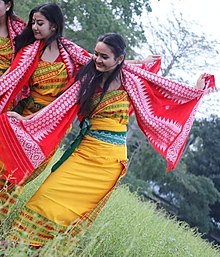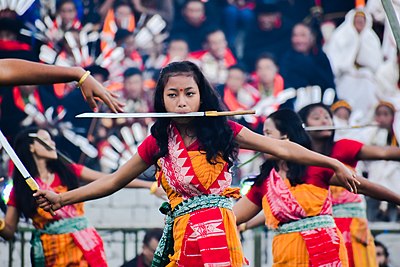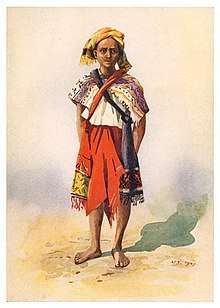Boro people
The Boro (also Bodo[6]; both pronounced [boːɽoː]) is the largest ethnolinguistic group in the Assam state of India. They are a part of the greater Bodo-Kachari family of ethnolinguistic groups and are spread across northeastern India. They are concentrated mainly in the Bodoland autonomous region of Assam, though Boros inhabit all other districts of Assam.[7]
Boro, Kachari | |
|---|---|
 Boro bwisagu dance in traditional attire | |
| Total population | |
| 1.4 million[1] | |
| Regions with significant populations | |
| *Assam | 30% of the population of Bodoland[2] |
| Languages | |
| Bodo | |
| Religion | |
| Ba-Thou • Hinduism • Christianity | |
| Related ethnic groups | |
| Kachari people | |
| Part of a series on the |
| Culture of Assam |
|---|
 |
|
Proto-historic
Classical Medieval
Modern |
|
|
|
Festivals
|
|
Religion Major
Others |
|
History
Archives
Genres
Institutions
Awards
|
|
Music and performing arts |
|
Media |
|
Symbols
|
Boros speak Boro language, a Boro-Garo language of the Tibeto-Burman family, which is recognized as one of twenty-two scheduled languages in the Indian Constitution.[8] and over two-third of the people are bilingual, speaking Assamese as second language.[9] The Boro along with other cognate groups of Bodo-Kachari peoples are prehistoric settlers who are believed to have migrated at least 3000 years ago[10]. The Bodo-Kachari were also some of the first people to rear silkworms and produce silk material and were considered to be advanced in rice cultivation in Assam during this time period.[11][12]
The Boro people are recognized as a plains tribe in the Sixth Schedule of the Indian Constitution, and have special powers in the Bodo Territorial Region, an autonomous division.
Etymology of Boro

The Boros are sometimes known as Kacharis and Mech to others, but self-identify as Bodo or Boro,[13] though the correct form is Boro.[14] Boro comes from Bara-fisa, which means "son of Bara", where Bara stands for "man" or "male member" of the group.[15]
There is a saying of Boro people, Boro hari, geder hari, meaning "Boro people, great people", So, Dalton concluded Boro means "great people".[16] Similarly, in the Kokborok language, Borok means man ('K' being a suffix for every noun), so logically Boro would mean man even in the Boro language.[17] Brahma opines that Boro might have originated from the Tibetan word Hbrog or Hbrogok, meaning Man. Generally, the word Boro means a man, in the wider sense Boro means a human being (but not specific to a female member of the family) in the languages used by Bodo-Kachari peoples.[18]
Language
The Boro language is a member of the Sino-Tibetan language family. It belongs to the Boro-Garo group of the Assam-Burmese branch of the Sino-Tibetan family.
Religion
Boros were polytheist. They worshiped dozens of Hindu deities like Siva, Durga, Kali, Ram and Krishna along with tribal deities like Bathou or Shijou, Mainao, Mairong and Agrang. In 1971, about 95% of Boros were Hindus and 5% were Christians.[19]
Traditionally, Boros practiced Bathouism, which is the worshiping of forefathers, known as Obonglaoree. The shijou tree (in the genus Euphorbia) is taken as the symbol of Bathou and worshiped. It is also claimed as the supreme god. In the Boro language, Ba means five and thou means deep. Since Boros believe in the five mighty elements of God – land, water, air, fire, and ether – the number five has become significant in the Bathou religion.
The Shijou tree is encircled by eighteen pairs of ornamental bamboo sticks and five pairs of rings of bamboo. In front of Shijou, within the bamboo ring, there is a "dove heart".[20]
According to Bathouism, before the creation of the universe there was simply a great void, in which the supreme being 'Aham Guru', Anan Binan Gosai or Obonglaoree existed formlessly. Aham Guru became tired of living a formless existence and desired to live in flesh and blood. He descended on this great void with all human characteristics and created the universe.[21]
In addition to Bathouism, Boro people also follow Hinduism, especially Hoom Jaygya. For this worship through fire ceremony, a clean surface near a home or courtyard is prepared. Usually, worship offerings include a betel nut called a 'goi' and a betel leaf called a 'pathwi' or 'bathwi' and rice, milk, and sugar. Another important Hindu festival, the Kherai Puja, where an altar is placed in a rice field, is the most important festival of the Boros. However, caste and dowry practices are not practiced by the majority of Boro Hindus, who follow a set of rules called Brahma Dharma.[20]
Some Boro people practice Christianity, predominantly Baptism. The major associations are the Boro Baptist Convention and Boro Baptist Church Association. Other denominations include the Church of North India, Lutheranism, the Believers' Church, Roman Catholicism, and Pentecostalism. Most Boro Christians' practices are a mixture of tribal and Christian traditions.
Occupation and Population distribution
Boros are mostly settled farmers. Boro farmers also have traditional irrigation called Dong system.[22]
Folk tradition and mythology
The history of the Boro people can be explained from folk traditions. According to Padma Bhushan winner Suniti Kumar Chatterjee, mythologically, Boros are "the offspring of son of the Vishnu and Mother-Earth" who were termed "Kiratas" during the Epic period.[23] Basumatary, the largest sub-tribe of Boro means Sons of the Soil.[24]
History

According to Hodgson, since the people who were known as Kacharis and Mech to others called themselves Boro, and also the Kachari chief deities, Siju, Mairong, and Agrang, are also Mech deities, the term Boro is the proper designation for the tribes.[25] The exonym Mech originated from the Sanskrit word Mleccha.[26] Boros were repeatedly called as Mleccha or Mech. According to Alamgirnamah, Cooch Behar was inhabited by Koch and Mech.[27] In ancient Sanskrit literatures, Boros were called as Kiratas and Mlecchas.[28] Copperplate land grant inscription related to Ramca and Mahalia Kacharis were found[29]
Important clans
The important clans of Boros are:[30] Aroi or Ari or Ary is suffix used for clan.
- Swarg-Aroi; In Sanskrit, Swarga means heaven. The clan is heaven folk. The clan never worked as cultivators. They were also known as Deoris and Ojhas.
- Basumati-Aroi; In Sanskrit, Basumati means earth. The clan is earth folk. The clan had certain privileges over land not possessed by others. Basumatary, the largest sub-tribe of Boro also mean Sons of the Soil.[31]
- Ramsa-Aroi; The clan is Ramsa folk. Ramsa is a village in Betna Mouza, Undivided Kamrup. Ramsa is a hill in Kharguli, Kamrup. Ram-sa (Ram's people) is the name by which Kacharis living in the plains were known to their brethren in the hills.
- Mahalia-Aroi; Mahalia Kacharis came to known as Mahilari.
- Hajo-Aroi; Many Boros worshiped Raja Hajo. Hajoari related to Hajo. Hajo means Hill.
Notable people
- Rajni Basumatary[32] Filmmaker and actress
- Harishankar Brahma[33] 19th Chief Election Commissioner of India
- Upendra Nath Brahma,[34] Boro activist
- Ranjit Shekhar Mooshahary,[35] IPS officer and former governor of Meghalaya
- Halicharan Narzary,[36] Indian footballer
See also
- Bodo Sahitya Sabha
- Bodo culture
- Ual (tool)
References
- "Census report 2011" (PDF). Retrieved 5 January 2020.
- "Non-Bodos Call The Fresh Bodoland Accord "Discriminatory"". NDTV.com. Retrieved 17 August 2020.
- "639 Identifier Documentation: aho – ISO 639-3". SIL International (formerly known as the Summer Institute of Linguistics). SIL International. Retrieved 29 June 2019.
Ahom [aho]
- "Population by Religious Communities". Census India – 2001. Ministry of Home Affairs, Government of India. Retrieved 1 July 2019.
Census Data Finder/C Series/Population by Religious Communities
- "Population by religion community – 2011". Census of India, 2011. The Registrar General & Census Commissioner, India. Archived from the original on 25 August 2015.
- (Bhatt 2005:20)
- (Dikshit 2013:376)
- "List of languages in the Eighth Schedule" (PDF).
- (Dikshit 2013:375)
- "Most scholars suggest that the first Tibeto-Burman-speaking peoples began to enter Assam at least 3,000 years ago." (DeLancey 2012:13-14)
- "Handloom and Textile of Bodos" (PDF). G Brahma PHD Thesis: 139.
- (Chattarji 1951:95-96)
- "The people very seldom call themselves by any other name other than Bodo or Boro." (Mosahary 1983:42)
- "It is important to note here whether the name is Bodo or Boro. It is undoubtedly Boro, which means 'great people' and not Bodo, which many of the people themselves call." (Mosahary 1983:42)
- "(W)e have references to the term Bara-fisa meaning child of the Baras and the term Bara-fisa must have been subsequently termed as simply as Bara pronounced as Boro. Dr P C Bhattacharya writes that like other tribal names in Assam the name Bara stands for man or male member (Mosahary 1983:44)
- In this regard, E T Dalton has come closer to the truth when he observes that 'Boro' means great people. This may be examined in the light of the Boro saying, "Boro hari,geder har" - Boro people, great people.(Bhatt 2005:20)
- (Bhatt 2005:20)
- (Brahma 2008:1)
- (Dixit 2013:375)
- "HOME". udalguri.gov.in. Archived from the original on 10 April 2017. Retrieved 2 April 2017.
- Basumatary, Dhuparam. Boro Kachari Sonskritir Kinchit Abhas. pp. 2–3.
- Devi, Chandam Victoria (1 April 2018). "Participatory Management of Irrigation System in North Eastern Region of India". International Journal of Rural Management. 14 (1): 69–79. doi:10.1177/0973005218765552. ISSN 0973-0052.
- "RCILTS, Phase-II". iitg.ac.in. Archived from the original on 30 April 2019. Retrieved 30 April 2019.
- (Sen 1999:44)
- (Jacquesson 2008:21)
- (Chattarji 1951:97) Sanskritized version of Mech is Mleccha.
- (Ghulam 1902:11) Cooch Behar was inhabited by Mech & Koch. Raja belong to first tribe.
- (Chattarji 1951:97-98)
- (Thakuria 2015:96)The charter records a grant of 186 purās of land, made to five persons, viz. Kacharimahalia Badnagaria, Ramca and Bajhparhania and Chutiya, who offered service to the families of medhis, bhakatas and the brahmanas of the Darrangirājya. The charter was issued by king Pramatta Singha in śaka 1667.
- "The Bodos" (PDF). Culture and Society.
- (Sen 1999:44)
- "Actress to screen conflict tale in rural BTAD". 31 May 2019. Retrieved 18 March 2020.
- ,"The Assam Tribune Online". www.assamtribune.com. 19 January 2015. Retrieved 24 January 2020.
- "Bodofa Upendra Nath Brahma's death anniversary observed by hundreds of people in Kokrajhar". The Sentinel. 2 May 2019. Retrieved 3 February 2020.
- "BSF gets first Bodo DG". The Hindu. 11 January 2005. Retrieved 14 January 2020.
- "NEFU Player Holicharan Narzary Ties Knot With Geetanjali Deori". The Sentinel. 4 October 2019. Retrieved 14 January 2020.
Bibliography
| Wikimedia Commons has media related to Bodo people. |
- Bhatt, S.C. (2005). Land and people of Indian states and union territories. India: Gyan Publishing House. ISBN 9788178353562.CS1 maint: ref=harv (link)
- Brahma, Nirjay Kumar (2008). "Introduction: Interpretation of Bodo or Boro". Socio political institutions in Bodo society (PhD). Guwahati University. hdl:10603/66535.CS1 maint: ref=harv (link)
- Chattarji, Suniti Kumar (1951). Kirata-Jana-Krti. Calcutta: The Asiatic Society.CS1 maint: ref=harv (link)
- DeLancey, Scott (2012). Hyslop, Gwendolyn; Morey, Stephen; w. Post, Mark (eds.). "On the Origin of Bodo-Garo". Northeast Indian Linguistics. 4: 3–20. doi:10.1017/UPO9789382264521.003. ISBN 9789382264521.
- Dikshit, K. R.; Dikshit, Jutta K. (2013). North-East India: Land, People and Economy. Springer Science & Business Media. pp. 375–376. ISBN 978-94-007-7055-3.CS1 maint: ref=harv (link)
- Ghulam, Salim Husain (1902). Riyazu-s-salatin: a history of Bengal. The Asiatic Soceity of Bengal.CS1 maint: ref=harv (link)
- Jacquesson, François (2008). "Discovering Boro-Garo" (PDF). History of an Analytical and Descriptive Linguistic Category. Archived from the original (PDF) on 3 August 2019. Retrieved 15 September 2019.CS1 maint: ref=harv (link)
- Mosahary, R N (1983). "The Boros : Their Origin, Migration and Settlement in Assam" (PDF). Proceedings of Northeast India History Association. Barapani: Northeast India History Association. pp. 42–70. Archived from the original (PDF) on 1 July 2019. Retrieved 30 June 2019.CS1 maint: ref=harv (link)
- Sen, Sucheta (1999). "INTRODUCING THE BODOS". Womens participation in the Bodo movement (PhD). North-Eastern Hill University. hdl:10603/65670.CS1 maint: ref=harv (link)
- Thakuria, Gitanjali (2015). "SURVEY OF THE INSCRIPTIONS AND THEIR TECHNICAL ASPECTS". Studies in the inscriptions of medieval assam (PhD). Guwahati University. hdl:10603/50862.CS1 maint: ref=harv (link)
Further reading
- Deka, Hira Moni (2009). "The Historical Background of Bodo Movement". Politics of identity and the bodo movement in Assam (PhD). Guwahati University. hdl:10603/67844.CS1 maint: ref=harv (link)
- Endle, Sidney (1911). The Kacharis. MACMILLAN AND CO. LIMITED.CS1 maint: ref=harv (link)
- Kakoty, Suchitra (1981). "The Historical Background of the Bodo-Kacharis". A study of the educational development of the bodo tribe during the post independence period with particular reference to the northern region of Assam (PhD). Guwahati University. hdl:10603/67775.CS1 maint: ref=harv (link)
- Sen, Debasis (1984). "Ethnic Elements in the Political Life of Ancient Assam". Proceedings of the Indian History Congress. 45: 101–106. JSTOR 44140186.CS1 maint: ref=harv (link)
- Siiger, Halfdan (2015). The Bodo of Assam: Revisiting a Classical Study from 1950 (PDF). NIAS Press. ISBN 978-87-7694-160-4. Archived from the original (PDF) on 11 August 2020.
.jpg)